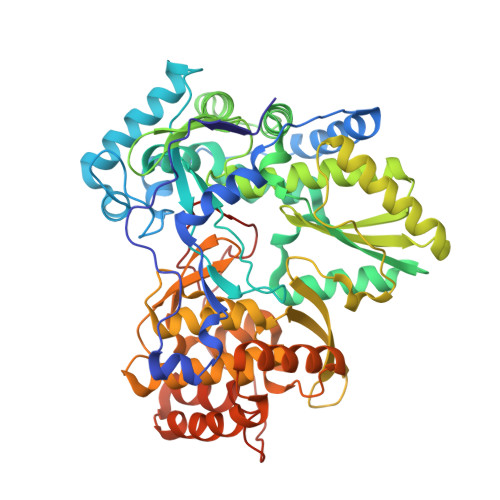Hydrophobic and Charged Residues in the C-Terminal Arm of Hepatitis C Virus RNA-Dependent RNA Polymerase Regulate Initiation and Elongation.
Cherry, A.L., Dennis, C.A., Baron, A., Eisele, L.E., Thommes, P.A., Jaeger, J.(2015) J Virol 89: 2052-2063
- PubMed: 25428878
- DOI: https://doi.org/10.1128/JVI.01106-14
- Primary Citation of Related Structures:
4RY4, 4RY5, 4RY6, 4RY7 - PubMed Abstract:
The RNA-dependent RNA polymerase (RdRp) of hepatitis C virus (HCV) is essential for viral genome replication. Crystal structures of the HCV RdRp reveal two C-terminal features, a β-loop and a C-terminal arm, suitably located for involvement in positioning components of the initiation complex. Here we show that these two elements intimately regulate template and nucleotide binding, initiation, and elongation. We constructed a series of β-loop and C-terminal arm mutants, which were used for in vitro analysis of RdRp de novo initiation and primer extension activities. All mutants showed a substantial decrease in initiation activities but a marked increase in primer extension activities, indicating an ability to form more stable elongation complexes with long primer-template RNAs. Structural studies of the mutants indicated that these enzyme properties might be attributed to an increased flexibility in the C-terminal features resulting in a more open polymerase cleft, which likely favors the elongation process but hampers the initiation steps. A UTP cocrystal structure of one mutant shows, in contrast to the wild-type protein, several alternate conformations of the substrate, confirming that even subtle changes in the C-terminal arm result in a more loosely organized active site and flexible binding modes of the nucleotide. We used a subgenomic replicon system to assess the effects of the same mutations on viral replication in cells. Even the subtlest mutations either severely impaired or completely abolished the ability of the replicon to replicate, further supporting the concept that the correct positioning of both the β-loop and C-terminal arm plays an essential role during initiation and in HCV replication in general. HCV RNA polymerase is a key target for the development of directly acting agents to cure HCV infections, which necessitates a thorough understanding of the functional roles of the various structural features of the RdRp. Here we show that even highly conservative changes, e.g., Tyr→Phe or Asp→Glu, in these seemingly peripheral structural features have profound effects on the initiation and elongation properties of the HCV polymerase.
Organizational Affiliation:
Institute of Science & the Environment, University of Worcester, Henwick Grove, United Kingdom.
















